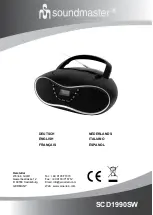
WMS 300
15
2. Check the transmitter batteries. If any battery is down or
you are in doubt, replace the batteries.
Use fresh batteries only. Refer to sections 8.1. and 8.2.
„Inserting/Replacing and Testing Batteries“.
3. Set the SQUELCH control on the SR 300 receiver to min-
imum (fully CCW). Set a higher threshold only if there is
any noise while the transmitter is off.
4. Check the performance area for „dead spots“, i.e.,
places where the field strength seems to drop and recep-
tion deteriorates. If you find any dead spots, try to elimi-
nate them by repositioning the receiver.
5. Check that the sensitivity of your transmitter has been ad-
justed correctly, referring to section 8.4. „Adjusting
Sensitivity on HT 300 and PT 300 Transmitters“.
6. Check that the audio output level on the SR 300 receiver
has been set to match the mixer or amplifier input level.
7. Check the antenna positions referring to section 9.
„Antenna Placement“.
11. How to Minimize Feedback
Feedback (usually a shrill whistling noise) is caused by your
microphone getting too close to a loudspeaker.
If this happens, we recommend that you IMMEDIATELY:
• mute the microphone (on the HT 300 set MIC 0/I (6) to 0, on
the PT 300 set MIC/MUTE/LINE (16) to MUTE);
• turn down the volume of the sound system; or
• move away from the loudspeaker; or
• turn the microphone away from the loudspeaker.
• As soon as the whistling stops, you can switch the trans-
mitter back on.
If you use the PT 300 with an omnidirectional microphone
and there is a persistent feedback problem, use a cardioid
microphone instead.
12. Cleaning
To clean the equipment surfaces, use a soft cloth moistened
with methylated spirits or alcohol.
To clean the integrated windscreen of the microphone ele-
ments (referring to fig. 8),
1. Press the wire mesh grill (13) against the transmitter shaft
and rotate the wire mesh grille (13) CW.
2. Remove the wire mesh grill (13) and remove the wind-
screen from the wire mesh grill (13).
3. Wash the windscreen in soap suds and allow it to dry
overnight.
4. Replace the windscreen in the wire mesh grill (13).
5. Press the wire mesh grill (13) against the transmitter shaft
and rotate the wire mesh grill (13) CW until it locks with
a click.
Important:
Never use the transmitter sensitivity control (5)/(19) to set the level
of your mixer or amplifer, etc.
To set the audio output level, use the VOLUME control (34) on the
SR 300 receiver only.
8.5. Battery Life
Use
fresh AA size 1.5-V batteries only!
We recommend
the following IEC LR61 (AA size) alkaline battery types:
Dry batteries
BRAND
guaranteed
typical
DURACELL
12 hrs.
12 hrs. 30 min.
PANASONIC
12 hrs.
14 hrs.
VARTA
10 hrs.
12 hrs.
If you intend to use any batteries other than those given in the
above table, contact AKG Vienna.
Rechargeable batteries (fully charged)
TYPE
guaranteed
typical
NiCd
4 hrs.
4 hrs. 30 min.
NiMH
6 hrs. 30 min.
7 hrs.
9. Antenna Placement
Reflections of metal parts, walls, ceiling, etc. may weaken or can-
cel the transmitter signal. The true diversity feature of the SR 300
largely compensates for this kind of interference.
Place your antennas as follows:
1. Place the SR 300 with installed RA 300 screw-on antennas
near the performance area. Make sure, though, that the trans-
mitter will never get any closer to the receiver than 10 ft. (3 m).
Otherwise, the transmitter signal may overload the RF input on
the receiver.
2. If you use remote antennas, place them near the performance
area and as high as possible (using, e.g., the ST 3000 stand).
Again, keep the transmitter a minimum of 10 ft. (3 m) away
from the receiver.
3. There should always be a direct line of sight between the trans-
mitting and receiving antennas.
4. Place the SR 300 receiver with secrew-on antennas or the re-
mote antennas at least 5 ft. (1.5 m) away from any big metal
objects, walls, ceilings, etc.
10. Before the Soundcheck
Before switching the sound system on, check the following:
1. Make sure that the transmitter and receiver operate on the
same frequency. Refer to section 7. „Carrier Frequencies“.
















































